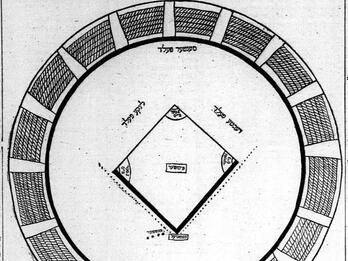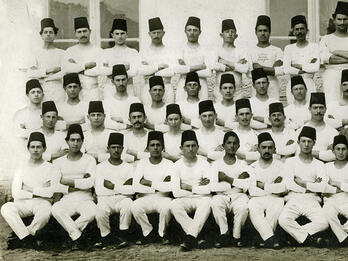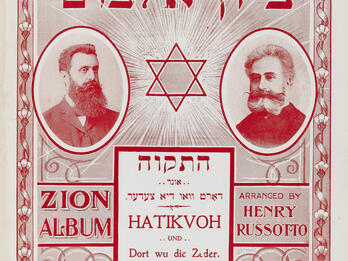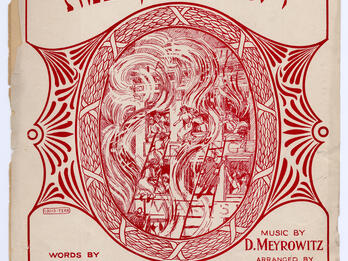A Sponsored Review of Dos Pintele Yid
We Command, We Recommend.
It is the duty of all Jews in New York and the vicinity to come to the People’s Theater on Thanksgiving—matinee and evening—as well as every Friday, Saturday, and Sunday to see “DOS PINTELE YID” [The Essence of a Jew] by B. Thomashevsky.
Dos Pintele Yid
The song that Master Harry Thomashevsky sings entitled “Dos Pintele Yid” is so holy and so tasteful that it would be no more than right if all Jews learned it and sang it in all Jewish homes and at all Jewish celebrations. The words and notes of the song were specially printed in Thomashevsky’s new newspaper Di yidishe bine [The Yiddish Stage], so that Jews could obtain [their own copy of] “Dos Pintele Yid.” Write to the Editorial Office, 169 East Broadway, and you will receive a copy of “Dos Pintele Yid.”
“Dos Pintele Yid” ought to become just as popular among Jews as “Hatikvah.”
The Dark Night
This is yet another excellent piece of work by the two great musicians, Perlmutter and Wohl. The whole audience shudders when, in the darkness of night, masked aristocrats attack Aaron the Jew. All that can be seen are glimmering lights in the air. Then suddenly, as if from the harmonies of a symphony orchestra, the sweet, lovely musical number “The Dark Night” overflows through the whole theater. All the Christians attack Aaron the Jew, drag him to the ark [of the synagogue] and force him to swear on the Torah scroll that he will never divulge the secret that the count will reveal to him. The oath is a piece of heavenly music. Then Aaron the Jew (Mr. Graf) raises the Torah scroll to heaven and begins the recitative “By my Torah, by my God” and the Christians reply “By his Torah, by his God.” Whoever understands music, and even those who understand nothing of music and harmony, must be inspired and enjoy a heavenly pleasure. Nobody shouts, nobody rants. The musicians do not rattle the brain with the drum. The cornets do not blare, the trombones do not rumble, and the violins do not squeak, but together are so sweet, so soft, so melodious, and the symphonic sounds keep time as if, from heaven, the wings of little angels were beating to awaken people to enjoy a sweet, lovely, heavenly, charming, delightful divinity. The whole number is as if angels were playing in heaven: quarreling and then being reconciled. We cannot find enough words to praise and to express the gratitude that we feel for the ensemble that sings the number and to the two great musicians Perlmutter and Wohl who wrote this number, as well as “The Dark Night” and “Dos Pintele Yid.”
Christian Man and Jewish Woman
The aristocratic Christian count recognizes his former lover, the Jewish girl he had seduced, who is now a maid at the house of Leyzer the smith. The scene is played wonderfully by Madam Abramovitch and Mr. Zuckerberg—so naturally and with such restraint that you simply forget that we are dealing with actors. You see them in reality. Bravo, bravo, bravo! That is all we can say about the beautiful and well-done scene.
The second tableau in the Second Act takes place at the masked ball that has been arranged by Jacob the lawyer to help build a Jewish hospital. All the various nationalities are represented. This is the most beautiful scene that the Yiddish theater has given us in years. The decorations are heavenly—the white marble room with the marble statues, the charming garden with paths and fountains that can be seen through the large window, the marble steps with arches covered in flowers. In a royal oper house, you could not expect to see anything more beautiful.
Various Nationalities
The four Turks in their silk and satin clothes stitched with gold thread—their clothes are dazzling and opulent in their natural Oriental glory. This quartet of four Turks is a pearl of the musical world. Their melody is so beautiful, so authentically Oriental and the orchestration so excellent that it is simply delightful to see and hear this famous Turkish quartet with its original Turkish march.
The Four Tyroleans
The beautiful four Tyroleans are called out when it is their turn: four beautiful Tyroleans appear in their original Tyrolean costumes and characters. The music as well as the dances are beautiful and original and make a great impression on audiences and arouse great applause in the music world. They deserve to be praised and to receive a hearty bravo.
The Hungarians
The Hungarians are the hit of the show. The People’s Theater has selected two choice singers. The Hungarian visitors to the People’s Theater forget that they are in a New York Yiddish theater. They are in Budapest, listening to their original Hungarian music and dance. We recommend that all Hungarians go see Dos Pintele Yid.
The Romanians
The Romanian number is true, authentic, and Oriental—a cheerful delight. We recommend that all Romanians go hear their true, original Romanian music and dances.
Mrs. Thomashevsky and Mr. Bernstein: A Devil with a Hasid
This cannot be described. One cannot convey on paper what those two angels of laughter, these comedic gods, achieve in this number. Mrs. Thomashevsky as a golden Mephistopheles and Mr. Bernstein as half-Hasid, half-Turk—you have to see how the two kings of humor teach the Germans how to dance a Jewish dance.
Mr. Thomashevsky and Madam Zuckerberg: Our Flag of Zion
“Open wide your gates, Jerusalem!” That is the duet sung in the Second Act by our two charming singers and the ensemble. Madam Zuckerberg carries in a Zionist flag and the whole theater is filled with holy joy and Jewish enthusiasm. That is a holy scene, an honest scene, a Jewish scene for Jewish children. It is what is holiest for Jews and for Dos Pintele Yid.
The Christian Father and His Jewish Son
When the Christian father recognizes his own child and learns that he is a Jew—this is a touching and heartrending scene, brilliantly executed, and sincerely and charmingly acted. The scene must be viewed to enjoy the heavenly pleasure of Dos Pintele Yid.
Take a Guess
That is the excellent couplet that Madam Thomashevsky, the queen of all Yiddish actresses, sings and dances. This animates the whole audience and the whole theater sings and enjoys itself while learning the song “Take a Guess” [“Shtoys zikh on”]
“I Am Happy, I Am Fortunate”
That is Mr. Bernstein’s song and lyrics in Dos Pintele Yid. Whoever hasn’t seen Bernstein’s mimicry, whoever hasn’t heard him sing, whoever hasn’t seen him dance the Jewish dance “It’s a Pleasure to Be a Jew”—that person is not happy, is not fortunate, and cannot say that he is a Jew.
The Terrible Bridal Canopy
Such a sincere scene, when under the bridal canopy [khupe] the poor housemaid recognizes the wealthy groom as her own child. The wealthy lawyer embraces his own mother and leads her proudly to the canopy, where she gives her children her maternal blessing. This scene is so touching that the theater becomes [emotional] like Yom Kippur. You must see the touching scene performed by Mr. Thomashevsky and Mrs. Abramovitch.
American Guests
A trio is sung by Mrs. Thomashevsky, Mrs. Krims, and Miss Gold—“America” featuring an American flag and an American dance. The whole audience sings along and would like to dance along. You can feel American freedom in the air and all Americans ought to run see the trio “America” in Dos Pintele Yid.
Just Give to Charity, Little Man
That is sung by Madam Zuckerberg with such charm, such warmth, and such grace that we can boast about our new artist and say that she is the pride of our Jewish female singers.
The Fantasy of Dos Pintele Yid
This is the golden temple that is the count’s gift to the Jews for a synagogue. The Jews carry their Torah scrolls, their crowns, their flag, and gifts. It is so beautiful that its beauty cannot be described. It is so noble that its nobility exceeds anything that has been seen in any oper house in the whole world.
Jews, we recommend that you go see Dos Pintele Yid.
It will be performed on Thanksgiving Day, matinee and evening, and every Friday, Saturday, and Sunday evening.
Credits
Unknown, “Mir befelen, mir rekomendiren” [A Sponsored Review of Dos pintele yid], Yidishes tageblatt 25, no. 270 (Nov. 23, 1909): p. 6.
Published in: The Posen Library of Jewish Culture and Civilization, vol. 7.






